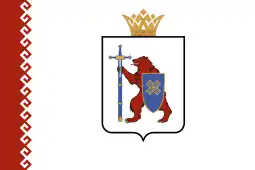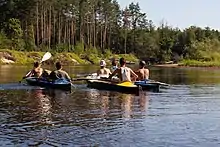Mari El
Mari El (Russian: Марий Эл; Meadow Mari: Марий Эл; Hill Mari: Мары Эл), officially the Mari El Republic,[lower-alpha 1] is a republic of Russia. It is in the European region of the country, along the northern bank of the Volga River, and administratively part of the Volga Federal District. The republic has a population of 696,459 (2010 Census).[12] Yoshkar-Ola is the capital and largest city.
Mari El Republic | |
|---|---|
| Республика Марий Эл | |
| Other transcription(s) | |
| • Meadow Mari | Марий Эл Республик |
| • Hill Mari | Мары Эл Республик |
 Coat of arms | |
| Anthem: "State Anthem of the Mari El Republic"[1] | |
.svg.png.webp) | |
| Coordinates: 56°42′N 47°52′E | |
| Country | Russia |
| Federal district | Volga[2] |
| Economic region | Volga-Vyatka[3] |
| Capital | Yoshkar-Ola |
| Government | |
| • Body | State Assembly[4] |
| • Head[4] | Yury Zaitsev[5] |
| Area | |
| • Total | 23,375 km2 (9,025 sq mi) |
| • Rank | 72nd |
| Population | |
| • Total | 672,093 |
| • Estimate (2018)[8] | 682,333 |
| • Rank | 64th |
| • Density | 29/km2 (74/sq mi) |
| • Urban | 68.4% |
| • Rural | 31.6% |
| Time zone | UTC+3 (MSK |
| ISO 3166 code | RU-ME |
| License plates | 12 |
| OKTMO ID | 88000000 |
| Official languages | Russian;[10] Mari (Meadow, Northwestern, and Hill variants)[11] |
| Website | http://gov.mari.ru |
Mari El, one of Russia's ethnic republics, was established for the indigenous Mari people, a Finnic nation who have traditionally lived along the Volga and Kama Rivers. The plurality of the republic's population are ethnic Russians (47.4%) and Mari (43.9%), with minority populations of Tatars and Chuvash. The official languages are Russian and Mari. Mari El is bordered by Nizhny Novgorod Oblast to the west, Kirov Oblast to the north, Tatarstan to the east, and Chuvashia to the south.
Geography
The Republic is located in the eastern part of the East European Plain of Russia, along and mostly to the north of the Volga River. The swampy Mari Depression is in the west of the Republic, contrasted by hillier landscapes in the east where the highest point of the Republic (at 278 metres (912 ft)[13]) is located. The Republic borders with Kirov Oblast in the north and east, the Republic of Tatarstan in the southeast and south, the Chuvash Republic in the south, and with Nizhny Novgorod Oblast in the west and north.
There are 476 rivers in the Republic, with the Volga and its tributaries being the major water arteries. Most rivers are considered to be minor—10–50 m (33–164 ft) wide and 0.5–1.4 m (1 ft 8 in – 4 ft 7 in) deep—and usually freeze between mid-November and mid-April. There are over 700 lakes and ponds; many located in the swampy areas and have areas of less than 1 km2 (0.39 sq mi) and depths of 1–3 m (3 ft 3 in – 9 ft 10 in). Lake Yalchik, occupying 150 hectares (370 acres), is the largest by area, while Lake Tabashinskoye is the deepest. Swamps cover large areas—10–70 km2 (3.9–27.0 sq mi) and up to 100 km2 (39 sq mi)—and usually freeze in December. While swamps tend to be shallow, with an average depth of 0.5–1.5 m (1 ft 8 in – 4 ft 11 in), they are impassable in fall and spring due to flooding.
Climate is moderately continental, with moderately cold and snowy winters and warm and often rainy summers. The average temperatures range from 18–20 °C (64–68 °F) in summer to −18 – −20 °C (0 – −4 °F) in winter. November is the windiest month of the year. Annual precipitation varies from 450 to 500 mm (18 to 20 in).
There are virtually no natural resources of industrial significance in the Republic. Other resources include peat, mineral waters, and limestone. About 50% of the Republic's territory is forested, although the level of forestation varies significantly from one district to another.
History
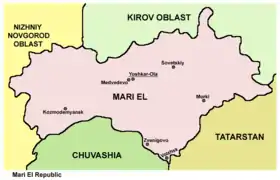
Ancient Mari tribes were known since the 5th century, though archaeologists suspect that the Mari culture is much older in its roots. Later their area was a tributary of Volga Bulgaria and the Golden Horde. In the 1440s it was incorporated into the Khanate of Kazan and was occupied by the Tsardom of Russia (governed by Ivan the Terrible) after the fall of Kazan in 1552.
After the Russian Revolution, under the Bolshevik regime, the Mari Autonomous Oblast was established on 4 November 1920. It was re-organized into the Mari ASSR on 5 December 1936, at the same time as the enactment of the 1936 Soviet Constitution. In its present form, the Mari El Republic was formed on 22 December 1990. On 21 May 1998, Mari El alongside Amur, Ivanovo, Kostroma, and Voronezh Oblast signed a power-sharing agreement with the federal government, granting it autonomy.[14] This agreement was abolished on 31 December 2001.[15]
The name of the republic is based on the ethnic self-designation of its indigenous population – Марий, "Mari" (from мари, "man, husband"), and эл, "country, land".[16]
Administrative divisions
Politics
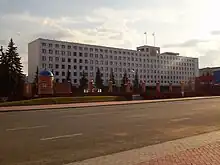
The head of government in the Mari El Republic is the Head (formerly President). As of 2017, the Head was Alexander Yevstifeyev, who was appointed in April 2017.[17]
The government of Mari El has been pursuing Russification in recent years, with the former head of the republic, Leonid Markelov, ordering many Mari language newspapers to close. Many ethnic Mari activists live in fear of violence. The Mari activist and chief editor Vladimir Kozlov was badly beaten after he criticized Markelov's government. Other Mari leaders have been subject to violence, legal persecution, and intimidation.[18]
The Mari people's native religion, based on the worship of the forces of nature, has encountered hostility as well. Vitaly Tanakov was charged with inciting religious, national, social, and linguistic hatred after publishing the book The Priest Speaks.[19]
The International Helsinki Federation for Human Rights (IHF) and the Moscow Helsinki Group (MHG), in an exhaustive 2006 report Russian Federation: The Human Rights Situation of the Mari Minority of the Republic of Mari El, found widespread evidence of political and cultural persecution of Mari people, and of "a broader trend of repression of dissidents in the republic".[20]
Demographics
Population: 696,459 (2010 Census);[12] 727,979 (2002 Census);[21] 749,386 (1989 Census).[22]
Vital statistics
- Source: Russian Federal State Statistics Service Archived April 12, 2008, at the Wayback Machine
| Average population (x 1000) | Live births | Deaths | Natural change | Crude birth rate (per 1000) | Crude death rate (per 1000) | Natural change (per 1000) | Fertility rates | |
|---|---|---|---|---|---|---|---|---|
| 1970 | 686 | 10,505 | 6,364 | 4,141 | 15.3 | 9.3 | 6.0 | |
| 1975 | 695 | 11,816 | 7,190 | 4,626 | 17.0 | 10.3 | 6.7 | |
| 1980 | 710 | 13,169 | 8,091 | 5,078 | 18.5 | 11.4 | 7.2 | |
| 1985 | 728 | 14,198 | 8,529 | 5,669 | 19.5 | 11.7 | 7.8 | |
| 1990 | 755 | 11,953 | 7,775 | 4,178 | 15.8 | 10.3 | 5.5 | 2,16 |
| 1991 | 756 | 10,578 | 7,786 | 2,792 | 14.0 | 10.3 | 3.7 | 1,97 |
| 1992 | 758 | 9,227 | 8,330 | 897 | 12.2 | 11.0 | 1.2 | 1,76 |
| 1993 | 758 | 8,019 | 9,622 | - 1,603 | 10.6 | 12.7 | - 2.1 | 1,56 |
| 1994 | 758 | 7,851 | 10,788 | - 2,937 | 10.4 | 14.2 | - 3.9 | 1,53 |
| 1995 | 757 | 7,337 | 9,999 | - 2,662 | 9.7 | 13.2 | - 3.5 | 1,43 |
| 1996 | 755 | 6,952 | 9,495 | - 2,543 | 9.2 | 12.6 | - 3.4 | 1,35 |
| 1997 | 752 | 6,782 | 9,625 | - 2,843 | 9.0 | 12.8 | - 3.8 | 1,32 |
| 1998 | 749 | 6,657 | 9,623 | - 2,966 | 8.9 | 12.8 | - 4.0 | 1,29 |
| 1999 | 746 | 6,597 | 10,674 | - 4,077 | 8.8 | 14.3 | - 5.5 | 1,28 |
| 2000 | 741 | 6,784 | 11,040 | - 4,256 | 9.1 | 14.9 | - 5.7 | 1,30 |
| 2001 | 736 | 6,832 | 11,434 | - 4,602 | 9.3 | 15.5 | - 6.3 | 1,30 |
| 2002 | 729 | 7,300 | 12,105 | - 4,805 | 10.0 | 16.6 | - 6.6 | 1,38 |
| 2003 | 723 | 7,515 | 11,861 | - 4,346 | 10.4 | 16.4 | - 6.0 | 1,40 |
| 2004 | 718 | 7,715 | 12,098 | - 4,383 | 10.7 | 16.9 | - 6.1 | 1,40 |
| 2005 | 713 | 7,475 | 12,256 | - 4,781 | 10.5 | 17.2 | - 6.7 | 1,34 |
| 2006 | 708 | 7,550 | 11,286 | - 3,736 | 10.7 | 15.9 | - 5.3 | 1,32 |
| 2007 | 704 | 8,306 | 10,745 | - 2,439 | 11.8 | 15.3 | - 3.5 | 1,45 |
| 2008 | 701 | 8,620 | 10,699 | - 2,079 | 12.3 | 15.3 | - 3.0 | 1,50 |
| 2009 | 699 | 8,896 | 10,435 | - 1,539 | 12.7 | 14.9 | - 2.2 | 1,60 |
| 2010 | 696 | 8,857 | 10,572 | - 1,715 | 12.7 | 15.2 | - 2.5 | 1,59 |
| 2011 | 694 | 9,066 | 9,816 | - 750 | 13.0 | 14.1 | - 1.1 | 1,66 |
| 2012 | 691 | 9,834 | 9,449 | 385 | 14.2 | 13.7 | 0.5 | 1,83 |
| 2013 | 689 | 10,088 | 9,444 | 644 | 14.6 | 13.7 | 0.9 | 1,93 |
| 2014 | 688 | 10,081 | 9,411 | 670 | 14.7 | 13.7 | 1.0 | 1,98 |
| 2015 | 687 | 9,951 | 9,448 | 503 | 14.5 | 13.7 | 0.8 | 1,99 |
| 2016 | 685 | 9,567 | 9,025 | 542 | 13.9 | 13.2 | 0.7 | 1,98 |
| 2017 | 683 | 8,147 | 8,493 | -346 | 11.9 | 12.4 | -0.5 | 1,75 |
Note: Total fertility rate source.[23]
Ethnic groups
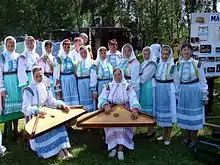
Though the Mari people have lived in the area for millennia, they did not have a designated territory before the Russian Revolution of 1917. According to the 2021 Census, only 58.2% of the Mari within Russia live in the Mari El Republic, while 20.1% live in the Republic of Bashkortostan (consisting of the Eastern Mari, who fled to Bashkorostan to escape religious persecution). During the last Soviet Census (1989), 4% of the Mari of the Soviet Union lived outside of Russia.
Since World War II, more ethnic Russians and Tatars have moved into the area. According to the 2021 Census,[24] Russians make up 52.5% of the republic's population (up from 47.4% in 2010), while the ethnic Mari make up 40.1% (down from 43.9%). Other groups include Tatars (4.8%), Chuvash (0.6%), and a host of smaller groups, each accounting for less than 0.5% of the total population.
| Ethnic group |
1926 Census | 1939 Census | 1959 Census | 1970 Census | 1979 Census | 1989 Census | 2002 Census | 2010 Census[12] | 2021 Census[24] | |||||||||
|---|---|---|---|---|---|---|---|---|---|---|---|---|---|---|---|---|---|---|
| Number | % | Number | % | Number | % | Number | % | Number | % | Number | % | Number | % | Number | % | Number | % | |
| Mari | 247,979 | 51.4% | 273,332 | 47.2% | 279,450 | 43.1% | 299,179 | 43.7% | 306,627 | 43.5% | 324,349 | 43.3% | 312,178 | 42.9% | 290,863 | 43.9% | 246,560 | 40.1% |
| Russians | 210,016 | 43.6% | 266,951 | 46.1% | 309,514 | 47.8% | 320,825 | 46.9% | 334,561 | 47.5% | 355,973 | 47.5% | 345,513 | 47.5% | 313,947 | 47.4% | 322,932 | 52.5% |
| Tatars | 20,219 | 4.2% | 27,149 | 4.7% | 38,821 | 6.0% | 40,279 | 5.9% | 40,917 | 5.8% | 43,850 | 5.9% | 43,377 | 6.0% | 38,357 | 5.8% | 29,317 | 4.8% |
| Chuvash | 2,184 | 0.5% | 5,504 | 0.9% | 9,065 | 1.4% | 9,032 | 1.3% | 8,087 | 1.1% | 8,993 | 1.2% | 7,418 | 1.0% | 6,025 | 0.9% | 3,656 | 0.6% |
| Others | 1,703 | 0.4% | 6,674 | 1.2% | 10,830 | 1.7% | 15,433 | 2.3% | 14,015 | 2.0% | 16,167 | 2.2% | 19,943 | 2.7% | 13,138 | 2.0% | 12,494 | 2.0% |
| 1 62,138 people were registered from administrative databases, and could not declare an ethnicity. It is estimated that the proportion of ethnicities in this group is the same as that of the declared group.[25] | ||||||||||||||||||
Religion

The religions with the most adherents in the republic are Russian Orthodoxy, the Mari native religion, the Old Believers, and Islam. The traditional Mari religion (Chimari yula) is still practised today by many Mari people and is the main religion of the Mari of Bashkortostan; also practised is a syncretism with Christianity. The Czars took drastic measures to force Christianity on the Mari, going so far as blowing up a holy mountain, and the persecution of the religion went on under the Soviet Union.
During the 1990s the religion was officially recognized by the State and began to revive. The Mari gather at around 520 holy groves where they offer animal and vegetable sacrifices, there are about 20 festivals yearly. Although traditional religion is one of Mari El's three officially recognized religions (along with Orthodoxy and Islam) Mari religious practises have come under increasing pressure, according to human rights groups.[28]

According to a 2012 survey,[26] 47.8% of the population of Mari El adheres to the Russian Orthodox Church, 6–15% adheres to the Mari native religion, 6% adheres to Islam, 4% are unaffiliated generic Christians, 1% are Old Believers and 1% are Orthodox Christian believers without church affiliation or members of other Orthodox churches. In addition, 25% of the population is "spiritual but not religious", 6% is atheist and 4.2% follows other religions or did not answer the question.[26]
Education
The most important facilities of higher education are Mari State Technical University and Mari State University,[29] both located in Yoshkar-Ola. There are also more than 900 primary and secondary schools located throughout the republic.
For the past few years, the Mari El Republic has been participating in the national project "Education" ("Oбразование"), which is designed to improve education throughout Russia by bringing new technology into the classroom, improving material conditions in schools, and providing financial awards to extraordinary students and teachers. Although the Mari language is officially a state language, Mari educators and administrators have been forced from their positions in recent years and Mari-language education has been defunded, according to the U.S. State Department,[30] the European Union, and others.[31]
Economy
The most developed industries are machine construction, metalworking, timber, woodworking, and food industries. Most of the industrial enterprises are located in the capital Yoshkar-Ola, as well as in the towns of Kozmodemyansk, Volzhsk, and Zvenigovo.
The largest companies in the region include Mariysky Oil Refinery (revenues of $502.2 million in 2017), Mari Pulp and Paper Mill ($137.12 million), Shelanger Chemical Plant "Siver" ($14.52 million), Marbiopharm ($14.02 million).[32]
Transportation
Traveling cheaply and quickly to various towns and villages within the Republic is made possible through a network of fifteen train stations, fifty-three bus stations, and numerous marshrutkas. The republic is connected to different regions throughout Russia by daily trains to and from Moscow and Kazan, flights on one commercial airline from Yoshkar-Ola Airport, located near Yoshkar-Ola, and a port on the Volga River in Kozmodemyansk. There are also four other minor river ports in the republic. Regional automobile code is 12.
Communication
Telephony, Internet service, and cable television are provided by VolgaTelecom.
Culture
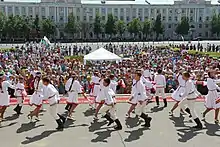
There are many museums located throughout the territory of the republic. The largest ones include the National Museum, the Museum of History, and the Museum of Fine Arts in Yoshkar-Ola; the Museum of Arts and History, the Ethnographic Open-Air Museum, and the Merchant Life Museum in Kozmodemyansk; and the Sheremetyev Castle Museum-reserve in Yurino. There are also museums dedicated to the poet Nikolay Mukhin and the composer Ivan Klyuchnikov-Palantay in Yoshkar-Ola and the house-museum of writer Sergei Chavayn in Chavaynur.
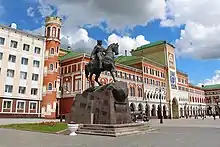
Five theaters are located in Yoshkar-Ola with performances in both the Russian and Mari languages.
Notable people
- Valentin Kolumb, poet
- Shabdar Osyp, author
- Andrei Eshpai, composer, pianist
See also
Notes
- Russian: Респу́блика Мари́й Эл, Respublika Mariy El; Meadow Mari: Марий Эл Республик; Hill Mari: Мары Эл Республик
References
- Constitution of the Mari El Republic, Article 16
- Президент Российской Федерации. Указ №849 от 13 мая 2000 г. «О полномочном представителе Президента Российской Федерации в федеральном округе». Вступил в силу 13 мая 2000 г. Опубликован: "Собрание законодательства РФ", No. 20, ст. 2112, 15 мая 2000 г. (President of the Russian Federation. Decree #849 of May 13, 2000 On the Plenipotentiary Representative of the President of the Russian Federation in a Federal District. Effective as of May 13, 2000.).
- Госстандарт Российской Федерации. №ОК 024-95 27 декабря 1995 г. «Общероссийский классификатор экономических регионов. 2. Экономические районы», в ред. Изменения №5/2001 ОКЭР. (Gosstandart of the Russian Federation. #OK 024-95 December 27, 1995 Russian Classification of Economic Regions. 2. Economic Regions, as amended by the Amendment #5/2001 OKER. ).
- Constitution, Article 6.2
- "Полиглот, человек из бизнеса и жесткий руководитель: что еще известно о новом главе Марий Эл Юрии Зайцеве". www.kazan.kp.ru (in Russian). September 14, 2022.
- "Сведения о наличии и распределении земель в Российской Федерации на 01.01.2019 (в разрезе субъектов Российской Федерации)". Federal Service for State Registration, Cadastre and Cartography. Archived from the original on February 9, 2022. Retrieved August 29, 2023.
- "Оценка численности постоянного населения по субъектам Российской Федерации". Federal State Statistics Service. Retrieved September 1, 2022.
- "26. Численность постоянного населения Российской Федерации по муниципальным образованиям на 1 января 2018 года". Federal State Statistics Service. Retrieved January 23, 2019.
- "Об исчислении времени". Официальный интернет-портал правовой информации (in Russian). June 3, 2011. Retrieved January 19, 2019.
- Official throughout the Russian Federation according to Article 68.1 of the Constitution of Russia.
- Constitution of the Mari El Republic, Article 15
- Russian Federal State Statistics Service (2011). Всероссийская перепись населения 2010 года. Том 1 [2010 All-Russian Population Census, vol. 1]. Всероссийская перепись населения 2010 года [2010 All-Russia Population Census] (in Russian). Federal State Statistics Service.
- ="SportTourism">Спортивный туризм в Татарстане. По просторам Марий Эл. Справка о местности. (in Russian)
- "Newsline - May 22, 1998 Yeltsin Signs More Power-Sharing Agreements with Regions". Radio Free Europe/Radio Liberty. June 20, 2008. Retrieved May 2, 2019.
- Chuman, Mizuki. "The Rise and Fall of Power-Sharing Treaties Between Center and Regions in Post-Soviet Russia" (PDF). Demokratizatsiya: 146.
- "Марийская республика - это... Что такое Марийская республика?". Словари и энциклопедии на Академике (in Russian). Retrieved December 19, 2021.
- "Alexander Yevstifeyev appointed Acting Head of Mari El". Kremlin.ru. April 6, 2017.
- United Nations High Commissioner for Refugees. "World Directory of Minorities and Indigenous Peoples - Russian Federation: Mari". Unhcr.org. Retrieved July 28, 2014.
- Russia Moves to Ban Religious Rites of Indigenous Finno-Ugric People Mari Archived October 21, 2007, at the Wayback Machine
- "Russian Federation: The Human Rights Situation of the Mari Minority of the Republic of Mari El : A Study of the Titular Nationality of One of Russia's Ethnic Regions" (PDF). Mhg.ru. Retrieved September 17, 2017.
- Russian Federal State Statistics Service (May 21, 2004). Численность населения России, субъектов Российской Федерации в составе федеральных округов, районов, городских поселений, сельских населённых пунктов – районных центров и сельских населённых пунктов с населением 3 тысячи и более человек [Population of Russia, Its Federal Districts, Federal Subjects, Districts, Urban Localities, Rural Localities—Administrative Centers, and Rural Localities with Population of Over 3,000] (XLS). Всероссийская перепись населения 2002 года [All-Russia Population Census of 2002] (in Russian).
- Всесоюзная перепись населения 1989 г. Численность наличного населения союзных и автономных республик, автономных областей и округов, краёв, областей, районов, городских поселений и сёл-райцентров [All Union Population Census of 1989: Present Population of Union and Autonomous Republics, Autonomous Oblasts and Okrugs, Krais, Oblasts, Districts, Urban Settlements, and Villages Serving as District Administrative Centers]. Всесоюзная перепись населения 1989 года [All-Union Population Census of 1989] (in Russian). Институт демографии Национального исследовательского университета: Высшая школа экономики [Institute of Demography at the National Research University: Higher School of Economics]. 1989 – via Demoscope Weekly.
- "Каталог публикаций::Федеральная служба государственной статистики". Gks.ru. Archived from the original on December 24, 2018. Retrieved July 28, 2014.
- "Национальный состав населения". Federal State Statistics Service. Retrieved December 30, 2022.
- "ВПН-2010". Perepis-2010.ru. Archived from the original on January 18, 2012. Retrieved July 28, 2014.
- "Arena: Atlas of Religions and Nationalities in Russia". Sreda, 2012.
- 2012 Arena Atlas Religion Maps. "Ogonek", № 34 (5243), 27/08/2012. Retrieved 21/04/2017. Archived.
- "Russian Federation: Amnesty International launches annual report and second Memorandum to President Medvedev". Amnesty. May 20, 2009. Archived from the original on August 11, 2014. Retrieved July 28, 2014.
- "marsu.ru". marsu.ru. Retrieved July 28, 2014.
- "Human Rights Reports". State.gov. January 20, 2009. Retrieved July 28, 2014.
- Fuller, Liz (April 8, 2008). "Russia: Marii El Begins To Look Like Belarus On The Volga". Radio Free Europe/Radio Liberty. Rferl.org. Retrieved July 28, 2014.
- Выписки ЕГРЮЛ и ЕГРИП, проверка контрагентов, ИНН и КПП организаций, реквизиты ИП и ООО. СБИС (in Russian). Retrieved October 20, 2018.
Sources
- 24 июня 1995 г. «Конституция Республики Марий Эл», в ред. Закона №21-З от 31 июля 2014 г. «О поправке 59 к Конституции Республики Марий Эл». Вступил в силу 7 июля 1995 г. (за исключением отдельных положений). Опубликован: "Марийская правда", 7 июля 1995 г. (June 24, 1995 Constitution of the Mari El Republic, as amended by the Law #21-Z of July 31, 2014 On Amendment 59 to the Constitution of the Mari El Republic. Effective as of July 7, 1995 (with the exception of several clauses).).
External links
- (in Russian) Old Official website of the Mari El Republic
- (in Russian) Official website of the Mari El Republic Archived April 8, 2020, at the Wayback Machine
- (in Russian) Industry in the Mari El Republic
- Mari El Republic nature views and sceneries
- A short Meadow Mari-English dictionary
- (in Russian) Meadow Mari-Russian-Japanese dictionary
- (in Russian) About nature in Mari EL republic
- Kimberli Mäkäräinen's Meadow Mari Grammar
- (in Russian) Map of Mari El
Further reading
- Daniel Kalder. Lost Cosmonaut: Observations of an Anti-tourist
